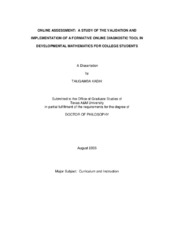| dc.contributor.advisor | Kulm, Gerald | |
| dc.contributor.advisor | Schielack, Janie | |
| dc.creator | Kadhi, TauGamba | |
| dc.date.accessioned | 2006-10-30T23:31:04Z | |
| dc.date.available | 2006-10-30T23:31:04Z | |
| dc.date.created | 2005-08 | |
| dc.date.issued | 2006-10-30 | |
| dc.identifier.uri | https://hdl.handle.net/1969.1/4361 | |
| dc.description.abstract | This Research and Design (R&D) study models the methodology
necessary to replicate an online assessment instrument designed to assess
student skills and facets of thought while understanding Multiple Meanings and
Models of Fractions (MUL) in college level developmental mathematics. The
researcher used cognitive research done in the area of fractions to design this
instrument that both documents and assesses facets of thought or reasoning
strategies used by students. The final facet cluster is a table that ranks these
facets from least to most problematic, documenting the student facets of thought
across the content objective MUL.
Over 500 student and teacher participants were used in the design and
development of Fraction Diagnoser. All participants were affiliated with college
developmental mathematics in Texas, representing four colleges and
universities. Forty-eight student participants were individually interviewed to
ascertain facets of understanding on the topic of MUL. Seven teacher
participants were individually interviewed as to the effectiveness of Fraction Diagnoser in the classroom after the final step of the R&D cycle. Content experts
were used to design the questions assessing skills and facets.
Fraction Diagnoser was built using the Borg and Gall R&D cycle as its
blueprint. Nine of the ten steps of the R&D cycle were used in the development
of the instrument, excluding just the final product revision due to cost and time
restraints. According to Borg and Gall (1996), a dissertation R&D should be
limited to a few steps, but all of the steps used for this R&D allowed for the
researcher to completely address all of the research questions. During the steps
of the R&D cycle, validation and reliability analyses were done to statistically
address the effectiveness of Fraction Diagnoser. Final interviews with the
teacher participants supported findings in recent research on the effective use of
online assessment. Implications for practice and recommendations for further
study were also addressed. | en |
| dc.format.extent | 4272284 bytes | en |
| dc.format.medium | electronic | en |
| dc.format.mimetype | application/pdf | |
| dc.language.iso | en_US | |
| dc.publisher | Texas A&M University | |
| dc.subject | online assessment | en |
| dc.subject | facets | en |
| dc.subject | fractions | en |
| dc.subject | student thought | en |
| dc.title | Online assessment: a study of the validation and implementation of a formative online diagnostic tool in developmental mathematics for college students | en |
| dc.type | Book | en |
| dc.type | Thesis | en |
| thesis.degree.department | Teaching Learning and Culture | en |
| thesis.degree.discipline | Curriculum and Instruction | en |
| thesis.degree.grantor | Texas A&M University | en |
| thesis.degree.name | Doctor of Philosophy | en |
| thesis.degree.level | Doctoral | en |
| dc.contributor.committeeMember | Capraro, Mary M. | |
| dc.contributor.committeeMember | Knight, Stephanie | |
| dc.type.genre | Electronic Dissertation | en |
| dc.type.material | text | en |
| dc.format.digitalOrigin | born digital | en |


